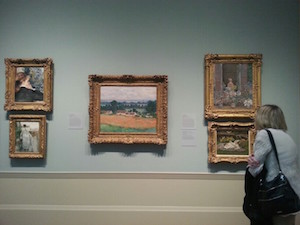 For this PALETTE event, the PALs and students were given the opportunity to take a field trip to the VMFA. The Virginia Museum Of Fine Arts is one of the top ten art museums in the country, and a well know Richmond tourist spot. Despite the dreary weather, many showed for this event, and the participants were split into two groups, first timers, and those that had visited the museum before. My PAL, Mickey and I, went with the group that had been to the VMFA before. Our tour guide Douglas, who was an artist himself, took us on a tour of the arts from the Renaissances to modern times. As we began our tour with a Renaissances piece of the Virgin Mary ascending into the heavens, one of the participants posed the question, “Do you think art has improved over the centuries and why?” Douglas did not have an answer, but was clearly intrigued by the question, and told us to keep it in mind as we continued on our tour.
For this PALETTE event, the PALs and students were given the opportunity to take a field trip to the VMFA. The Virginia Museum Of Fine Arts is one of the top ten art museums in the country, and a well know Richmond tourist spot. Despite the dreary weather, many showed for this event, and the participants were split into two groups, first timers, and those that had visited the museum before. My PAL, Mickey and I, went with the group that had been to the VMFA before. Our tour guide Douglas, who was an artist himself, took us on a tour of the arts from the Renaissances to modern times. As we began our tour with a Renaissances piece of the Virgin Mary ascending into the heavens, one of the participants posed the question, “Do you think art has improved over the centuries and why?” Douglas did not have an answer, but was clearly intrigued by the question, and told us to keep it in mind as we continued on our tour.
We did a brief run through of some prominent religious pieces, still lifes, impressionism, and ended with some 21st century symbolism. It was very interesting to see the art evolve and change throughout the centuries, yet still show signs of the same techniques of the classic pieces. It made me think of the continuity theory of aging. According to this theory, as we age we adapt to change by preserving a continuity of past social and psychosocial patterns (Atchley, 1989). This continuity can be both internal, (such as memory and temperament), or external, (hobbies, social groups, etc). Like older individuals, adapting to the ever changing world the art still showed signs of past patterns.
In the end, the group concluded that the older styles were much more in-depth and beautiful than modern day art. Personally, I think new-age art is just as beautiful because it blends old techniques, with new ones, creating something intriguing and meaningful. Just like the intergenerational experience of this course.
Ashley Holliday, graduate student in Gerontology
